1.5 Quick Guide on Thonny¶
Open and Run Code Directly¶
The code section in the projects tells you exactly which code is used, so double-click on the .py file with the serial number in the esp32-starter-kit-main\micropython\codes\ path to open it.
However, you must first download the package and upload the libraries, as described in 1.4 Upload the Libraries (Important).
Open code.
For example,
1.1_hello_led.py.If you double click on it, a new window will open on the right. You can open more than one code at the same time.
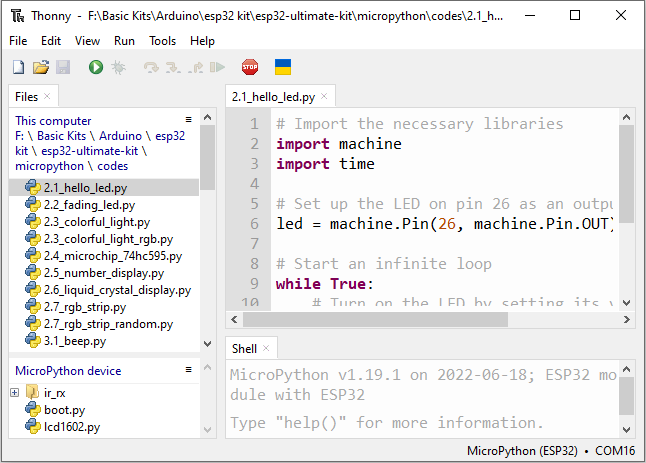
Plug the esp32 into your computer with a micro USB cable.
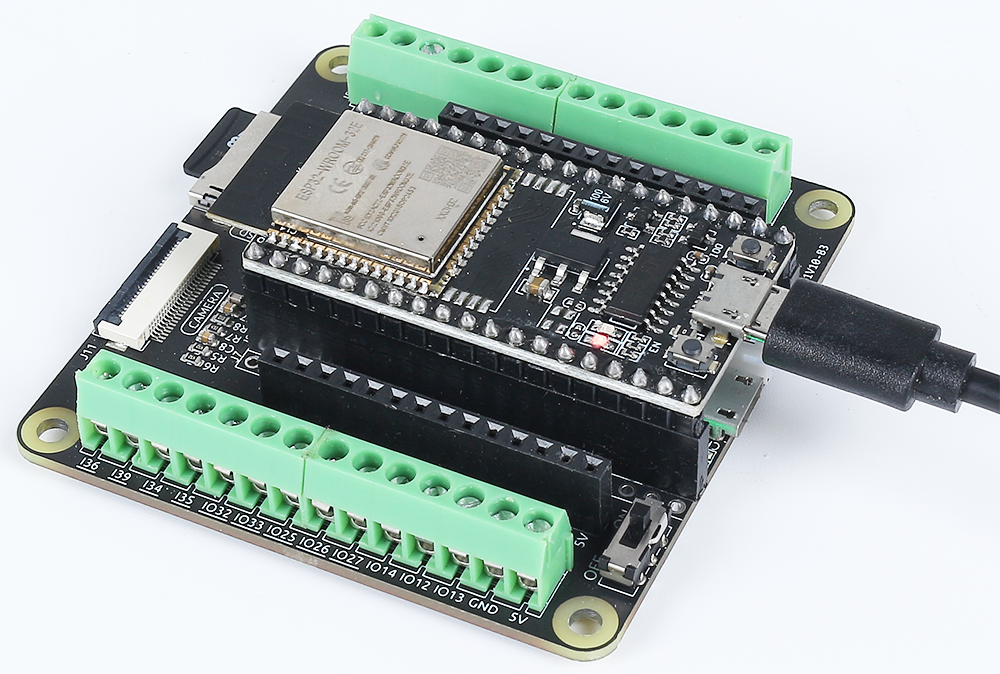
Select correct interpreter
Select the “MicroPython (ESP32).COMxx” interpreter.
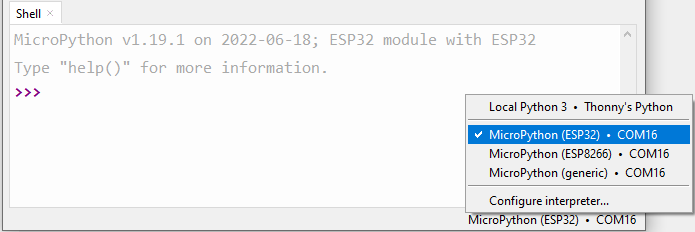
Run the code
To run the script, click the Run current script button or press F5.
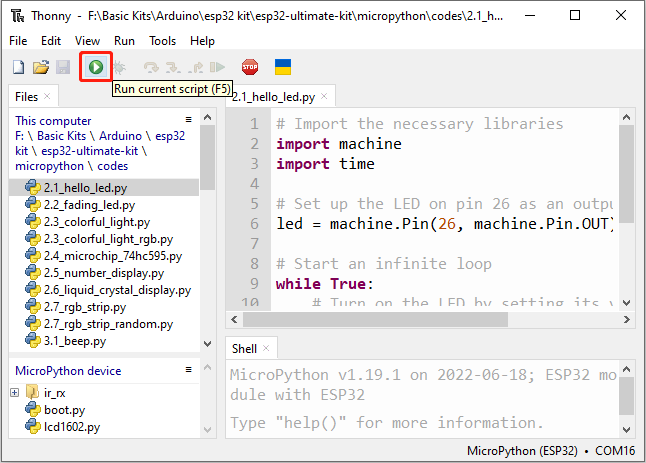
If the code contains any information that needs to be printed, it will appear in the Shell; otherwise, only the following information will appear.
Click View -> Edit to open the Shell window if it doesn’t appear on your Thonny.
MicroPython v1.19.1 on 2022-06-18; ESP32 module with ESP32 Type "help()" for more information. >>> %Run -c $EDITOR_CONTENT
The first line shows the version of MicroPython, the date, and your device information.
The second line prompts you to enter “help()” to get some help.
The third line is a command from Thonny telling the MicroPython interpreter on your Pico W to run the contents of the script area - “EDITOR_CONTENT”.
If there is any message after the third line, it is usually a message that you tell MicroPython to print, or an error message for the code.
Stop running

To stop the running code, click the Stop/Restart backend button. The %RUN -c $EDITOR_CONTENT command will disappear after stopping.
Save or save as
You can save changes made to the open example by pressing Ctrl+S or clicking the Save button on Thonny.
The code can be saved as a separate file within the MicroPython drive(ESP32) by clicking on File -> Save As.

Select MicroPython drive.
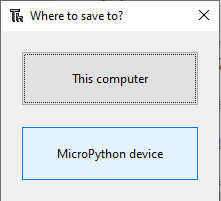
Then click OK after entering the file name and extension .py. On the MicroPython drive, you will see your saved file.
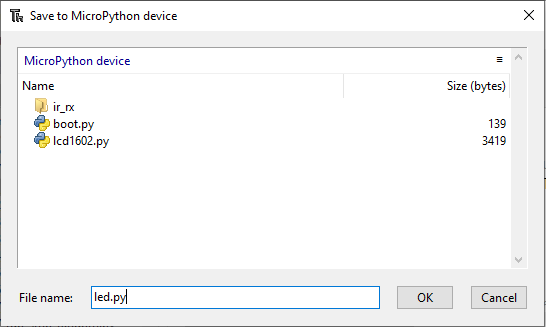
Note
Regardless of what name you give your code, it’s best to describe what type of code it is, and not give it a meaningless name like
abc.py. When you save the code asmain.py, it will run automatically when the power is turned on.
Create File and Run it¶
The code is shown directly in the code section. You can copy it to Thonny and run it as follows.
Create a new file
Open Thonny IDE, click New button to create a new blank file.
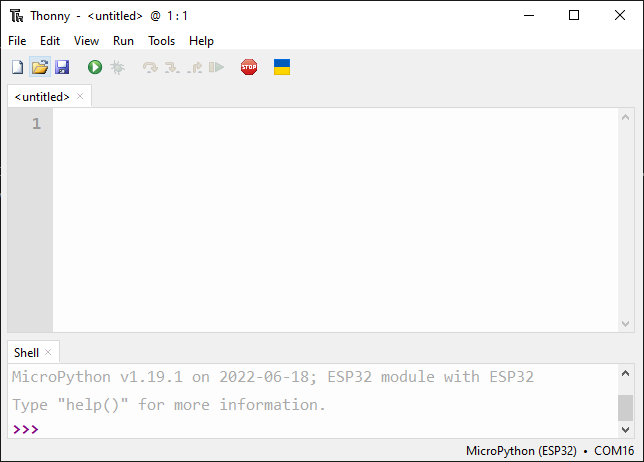
Copy code
Copy the code from the project to the Thonny IDE.
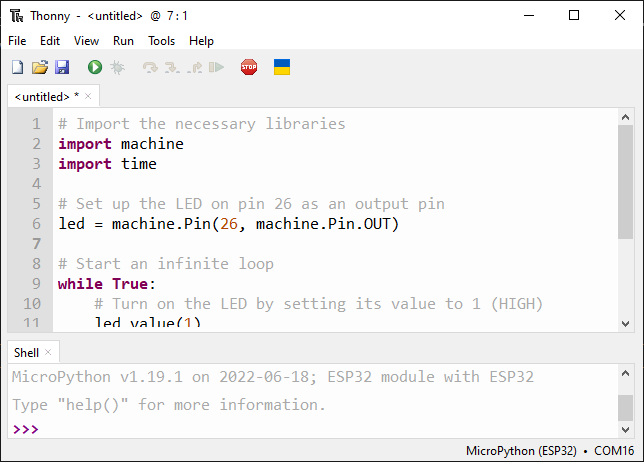
Plug the esp32 into your computer with a micro USB cable.

Select correct interpreter
Select the “MicroPython (ESP32).COMxx” interpreter in the bottom right corner.

Run the code
You need click Run Current Script or simply press
F5to run it.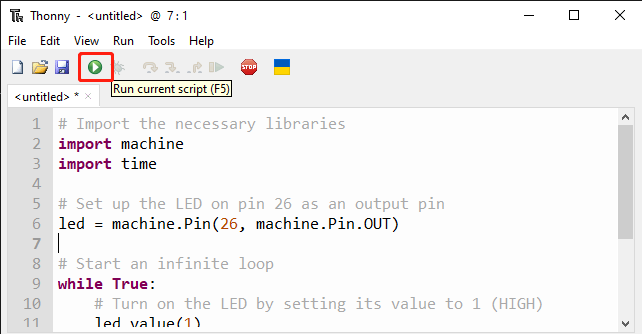
If the code contains any information that needs to be printed, it will appear in the Shell; otherwise, only the following information will appear.
Click View -> Edit to open the Shell window if it doesn’t appear on your Thonny.
MicroPython v1.19.1 on 2022-06-18; ESP32 module with ESP32 Type "help()" for more information. >>> %Run -c $EDITOR_CONTENT
The first line shows the version of MicroPython, the date, and your device information.
The second line prompts you to enter “help()” to get some help.
The third line is a command from Thonny telling the MicroPython interpreter on your Pico W to run the contents of the script area - “EDITOR_CONTENT”.
If there is any message after the third line, it is usually a message that you tell MicroPython to print, or an error message for the code.
Stop running

To stop the running code, click the Stop/Restart backend button. The %RUN -c $EDITOR_CONTENT command will disappear after stopping.
Save or save as
You can save the code by pressing Ctrl+S or clicking the Save button on Thonny. In the pop-up window, select the location where you want to save the file.

Then click OK or Save after entering the file name and extension .py.

Note
Regardless of what name you give your code, it’s best to describe what type of code it is, and not give it a meaningless name like
abc.py. When you save the code asmain.py, it will run automatically when the power is turned on.Open file
Here are two ways to open a saved code file.
The first method is to click the open icon on the Thonny toolbar, just like when you save a program, you will be asked if you want to open it from this computer or MicroPython device, for example, click MicroPython device and you will see a list of all the programs you have saved on the ESP32.
The second is to open the file preview directly by clicking View -> Files -> and then double-clicking on the corresponding
.pyfile to open it.